Native Shrubs for Mississippi Landscapes
There are 30 shrub species native to Mississippi that can be successfully used in home landscapes. The following descriptions of each species include:
- Native habitats
- Flowering, fruit, leaf, and form characteristics
- Wildlife values
Each listing also contains cultural tips and effective landscape uses. While many of these plants tolerate conditions not found in their native environments, it is always preferable to choose plants that are best suited to the site. Wholesale nurseries in your area may produce some of these plants; ask the manager about availability.
Tag Alder
Alnus serrulata (Ait.) Willd.
Family: Betulaceae
This tall, deciduous shrub can reach 15 feet in height. Tag alder is commonly found in wet, acidic soils of branch bottoms and flatwoods. Leaves are round in shape and have fine-toothed edges. This alder produces long, thin “catkin” (resembles a cat’s tail) flowers in late fall. (The flowers are conspicuously showy.) This shrub has a twisting, crooked trunk and makes an excellent specimen shrub. Several species of birds eat the seeds while deer and beaver feed on stems and leaves.
Sunlight: Sun to shade
Soil type: Wet or moist
Shrub type: Deciduous
Wildlife value: Medium
Flowering: Spring flowers
Red Buckeye
Aesculus pavia L.
Family: Hippocastanaceae
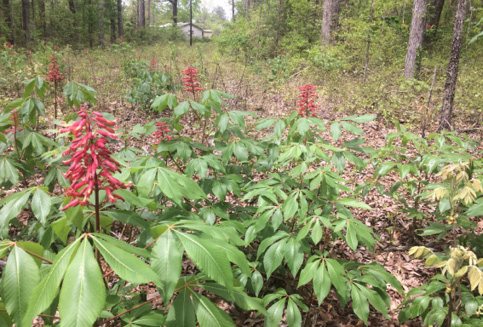
Although red buckeye forms a tree in more northern regions, it grows as a small, deciduous (seasonal shedding of leaves) shrub in most of the South. Rarely exceeding 10 feet in height, red buckeye is found on well-drained slopes of creek banks and rivers. Flower spikes that are large, showy, red, and a favorite food source for hummingbirds appear on the ends of branches in March and April. Buckeye forms a broad, mounding shrub and will develop large colonies from root suckers. It often loses leaves in midsummer because of leaf anthracnose (a fungal disease), but the plant is not injured. Red buckeye has handsome palmate (broad, flat, and lobed) compound leaves that turn yellow in the fall. For a natural look, plant the buckeye in shrub masses underneath trees that form a canopy.
Sunlight: Part sun to shade
Soil type: Dry to moist
Shrub type: Deciduous
Wildlife value: Medium
Flowering: Spring flowers
Groundsel Bush
Baccharis halimifolia L.
Family: Asteraceae
Groundsel bush is a finely branched, semi-evergreen shrub that reaches 12 feet in height and is about 6 feet wide. It multiplies in wet marshes, fields, and swamp areas. This shrub has a loose, irregular form similar to wax myrtle. It blooms in early fall with numerous billowy, white flowers that cover the plant. These flowers are a favorite nectar source for many butterfly species. Tolerant of both salt and freshwater areas, this shrub readily adapts to any sunny site.
Sunlight: Sun to part sun
Soil type: Wet or dry
Shrub type: Semi-evergreen
Wildlife value: High
Flowering: Fall flowers
American Beautyberry
Callicarpa americana L.
Family: Verbenaceae
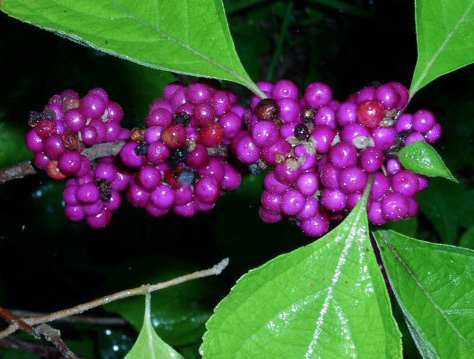
This fast-growing, deciduous shrub can reach up to 8 feet in height and almost 6 feet in width. Beautyberry has a broad, coarse leaf texture and turns bright yellow in fall. Commonly found at woodland edges and along fencerows, it is tolerant of poor soils. Small, rosy flowers appear along the branches in May and form showy, bright-purple fruits in late summer. These fruits are eaten by many species of birds and mammals. Beautyberry has a broad, mounding form in full sunlight and is effective in shrub masses or as a specimen plant.
Sunlight: Sun to part shade
Soil type: Dry to moist
Shrub type: Deciduous
Wildlife value: High
Flowering: Showy fall fruit
Sweetshrub
Calycanthus floridus L.
Family: Calycanthaceae
Sweetshrub is a medium-sized, upright, deciduous shrub that can reach 8 feet in height and 4 feet in width. It is occasionally found on drier soil types in fertile woodlands and along sandy streams and hillsides. This shrub has an attractive oval leaf with very prominent veins. In the fall, it turns bright yellow. Sweetshrub has a sweetly fragrant, reddish-brown flower in late spring. Few insects or diseases are found on this shrub species. It is effective in masses and in hedgerows in natural settings.
Sunlight: Sun to part shade
Soil type: Dry to moist
Shrub type: Deciduous
Wildlife value: Low
Flowering: Spring flower
Buttonbush
Cephalanthus occidentalis Linnaeus
Family: Rubiaceae
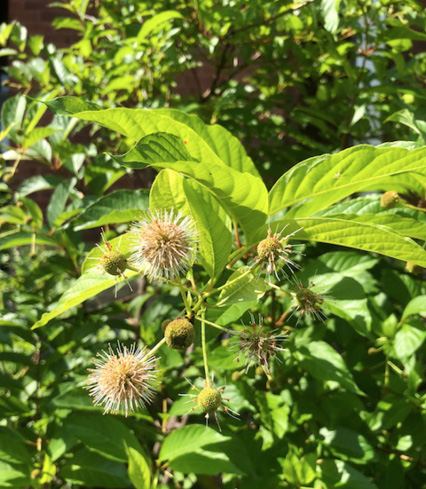
Buttonbush is a deciduous shrub that grows to 10 feet in height. It is found in wet soils near swamps, ponds, and lakes. This shrub has an interesting open, sprawling form and can occur in colonies. An unusual white, globe-shaped flower, which is visited by bees and butterflies, is produced throughout the summer. In the fall, the flower forms a round seed head that is eaten by several bird species. This shrub is suitable for shallow water areas at the edges of ponds.
Sunlight: Sun to part sun
Soil type: Wet or dry
Shrub type: Deciduous
Wildlife value: High
Flowering: Summer flowers
Fringe Tree
Chionanthus virginicus Linnaeus
Family: Oleaceae
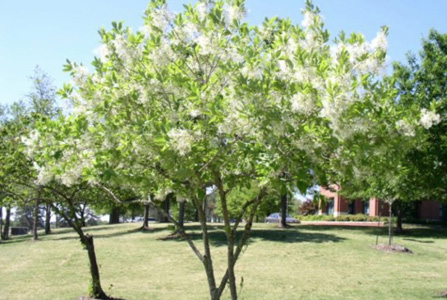
Fringe tree is a large, deciduous shrub or small tree that grows 20 feet high and 12 feet wide. It is found in upland pine forests in well-drained soil. It has a rounded, “shrubby” form and often has multiple trunks. Fringe tree blooms in spring, with white, fringe-like petals that have a slight fragrance. Small, blue fruits are produced in late summer and consumed by numerous birds and wildlife. The large, oval leaves have a yellow autumn color. Fringe tree is an excellent specimen tree for the home landscape.
Sunlight: Sun to part sun
Soil type: Dry to moist
Shrub type: Deciduous
Wildlife value: High
Flowering: Spring flowers
Buckwheat Tree
Cliftonia monophylla Gaertner
Family: Cyrillaceae
Buckwheat tree is a large, evergreen shrub that can reach 20 feet tall and 20 feet wide. It is found in the moist, acidic soils of swamps, bogs, and wet pinelands. Buckwheat has an upright, oval form with multiple trunks. White flower clusters appear at the ends of branches in winter and persist well into spring. Yellow “buckwheat” fruits appear in summer and are somewhat prominent.
Sunlight: Sun to part sun
Soil type: Wet or dry
Shrub type: Evergreen
Wildlife value: Medium
Flowering: Winter flowers
Summersweet
Clethra alnifolia Linnaeus
Family: Clethraceae
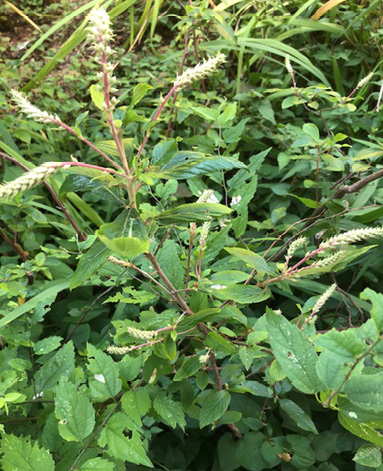
Summersweet is a deciduous shrub that averages 6 feet in height and 4 feet in width. It is found in moist, acidic soils of wet pine savannas, bogs, and swamps. The attractive, dark-green leaves are toothed and turn yellow in the fall. Fragrant, white bloom-spikes appear in early summer for several weeks. Summersweet has an upright form with medium-textured foliage and is excellent for use in natural settings.
Sunlight: Sun to part sun
Soil type: Wet or dry
Shrub type: Deciduous
Wildlife value: Medium
Flowering: Summer flowers
Dwarf Huckleberry
Gaylussacia dumosa (Andrz.) T & G
Family: Ericaceae
Dwarf huckleberry is a deciduous shrub that averages 4 feet in height and 4 feet in width. It is found in a variety of woodlands with acidic soils, including pine savannas and bogs. This huckleberry has an upright-to-mounding form and is often sculptural. The small, fine-textured leaves turn a brilliant red in autumn. Small, pink flowers bloom in spring and produce small, edible huckleberry fruits in early summer. These fruits are eaten by a variety of birds and other wildlife.
Sunlight: Sun to part sun
Soil type: Dry to wet
Shrub type: Deciduous
Wildlife value: High
Fruit: Summer fruits
Witch Alder
Fothergilla major (Sims) Lodd.
Family: Hamamelidaceae
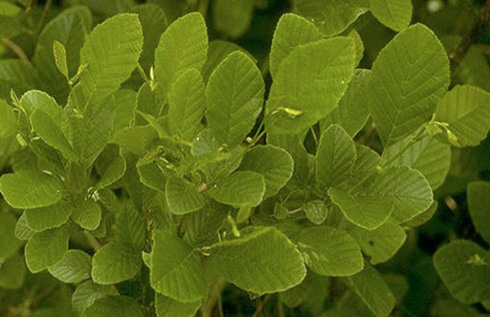
Witch alder is a deciduous shrub that reaches 8 feet in height and 5 feet in width. It is occasionally found in well-drained, acidic soils of dry woods. Witch alder has an upright form and is an effective understory shrub in natural settings. The large-toothed leaves have a red or orange fall color. Creamy-white bottlebrush flowers have a sweet fragrance and appear in early spring.
Sunlight: Part shade to shade
Soil type: Dry to moist
Shrub type: Deciduous
Wildlife value: Low
Flowering: Spring flowers
Witch Hazel
Hamamelis virginiana L.
Family: Hamamelidaceae
Witch hazel is a large, deciduous shrub or a small tree that may reach 15 feet tall. It is found in a variety of rich woodlands and along stream banks. The large, scalloped leaves are attractive in summer and produce a yellow autumn color. The shrub has strap-like, yellow flower petals that are fragrant and bloom from fall into winter. Witch hazel has a spreading, sculptural form and is effective in the landscape as an understory specimen plant.
Sunlight: Sun or shade
Soil type: Dry to moist
Shrub type: Deciduous
Wildlife value: Low
Flowering: Winter flowers
Oakleaf Hydrangea
Hydrangea quercifolia Bartram
Family: Hydrangeaceae
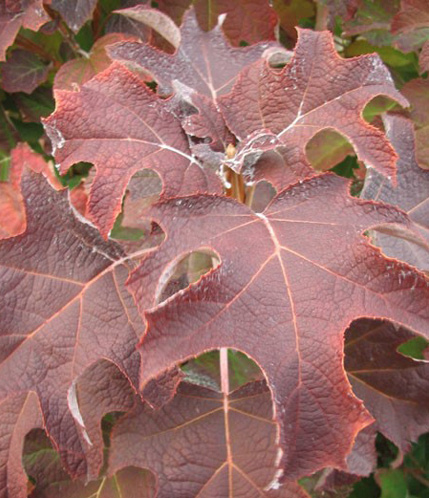
An excellent deciduous shrub with many ornamental qualities, oakleaf hydrangea grows to 6 feet tall and 4 feet wide. This species is found in fertile, well-drained woodlands of the state. The leaves are large and oak-like, turning a rich purple in the fall. Oakleaf hydrangea produces large, creamy-white flower heads in late spring. It is an excellent specimen plant for shady areas under trees in well-drained soil conditions.
Sunlight: Part shade to shade
Soil type: Well-drained, fertile
Shrub type: Deciduous
Wildlife value: Low
Flowering: Spring flowers
Bigleaf Gallberry Holly
Ilex coriacea (Pursh) Chapman
Family: Aquifoliaceae
A large, evergreen shrub that can reach 15 feet in height, bigleaf gallberry holly is native to wetland soils of pine flatwoods, swamp edges, and bogs. This holly tends to be upright in form with multiple stems. It makes an excellent hedge or barrier plant. Large, shiny, black fruits are produced in fall and winter. These holly fruits are eaten by a number of birds and small mammals. It is a good, tough holly that is tolerant of many extreme environments.
Sunlight: Sun to part sun
Soil type: Wet or dry
Shrub type: Evergreen
Wildlife value: High
Fruit: Winter fruits
Leucothoe
Leucothoe axillaris (Lam.) D. Don
Family: Ericaceae
Leucothoe is a small, evergreen shrub that grows to 3 feet in height and width. It is a low-spreading shrub with arching and loosely formed stems. It grows in wet, acidic soils near swamps, bogs, and creek beds. Small, white, fragrant blooms cluster along the flower stem from late winter to mid-spring. This evergreen shrub can get leaf spot. It is best suited to coastal areas.
Sunlight: Part sun to shade
Soil type: Dry or wet
Shrub type: Evergreen
Wildlife value: Low
Flowering: Spring flowers
Winterberry Holly
Ilex verticillata (L.) Gray
Family: Aquifoliaceae
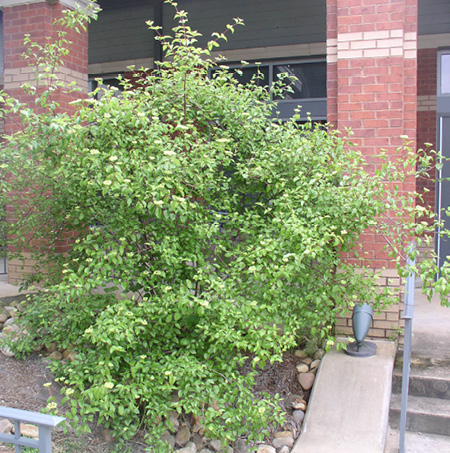
Winterberry holly is a deciduous shrub that can grow 10 feet high and 6 feet wide. It has an open, wide-spreading form with upright branches. This holly is found in wet woods, bogs, and along the sides of streams. Female plants produce large, red fruit in winter that persist well through cold weather. Nearby male plants are required for fruit set. It is an excellent specimen plant for courtyards and gardens.
Sunlight: Sun to part sun
Soil type: Wet or dry
Shrub type: Deciduous
Wildlife value: High
Fruit: Winter fruits
Star Anise
Illicium floridanum Ell.
Family: Illicaceae
Star anise is an evergreen shrub that can grow 8 feet high and 6 feet wide. It usually grows in dense thickets along stream banks and moist woods. Star anise has an upright, oval form with deep-green leaves of coarse texture. The leaves are heavily scented and noticeable when encountered. Deep-maroon, starry flowers cover the plant in early spring. Star anise is a good landscape plant for soils that are shaded, have good drainage, or maintain moisture.
Sunlight: Shade to part shade
Soil type: Dry to moist
Shrub type: Evergreen
Wildlife value: Low
Flowering: Spring flowers
Virginia Sweetspire
Itea virginica L.
Family: Iteaceae
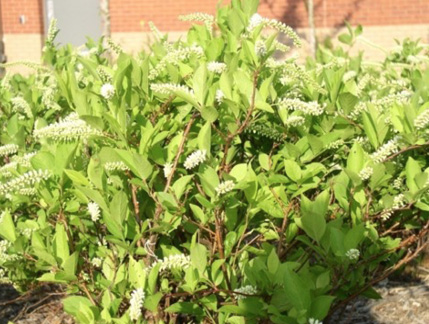
A deciduous shrub that grows 5 feet high and 3 feet wide, sweetspire is found along stream edges and swamps. It has an upright-to-spreading form with multiple stems. The medium-textured leaves turn a deep wine-red in autumn. Fragrant, white flower clusters appear at the ends of branches in April and May. This shrub is tolerant of many different garden conditions. Several cultivars are available.
Sunlight: Sun to part sun
Soil type: Dry or wet
Shrub type: Deciduous
Wildlife value: Medium
Flowering: Spring flowers
Snowbell
Styrax americanus Lam.
Family: Styracaceae
A little-known deciduous shrub, snowbell grows to 10 feet high and 6 feet wide. It is found in wet soils of bottomland hardwood forests and along stream edges. It has numerous small, white flowers that bloom from April through May. It typically has an upright, oval form.
Sunlight: Sun to part sun
Soil type: Wet or moist
Shrub type: Deciduous
Wildlife value: Medium
Flowering: Spring flowers
Yellow Native Azalea
Rhododendron austrinum (Sm.) Rehd.
Family: Ericaceae
This magnificent deciduous shrub grows 12 feet tall and 8 feet wide. Native to rich, well-drained woodlands along streams and rivers, it performs best in morning sun or filtered light. Rich yellow or orange, fragrant blossoms appear for three weeks in April and May. Yellow native azalea is sensitive to wet or poorly drained soil types, but it has few other problems. Many cultivars are available that exhibit different flower forms and colors.
Sunlight: Part sun to shade
Soil type: Dry to moist soils
Shrub type: Deciduous
Wildlife value: Low
Flowering: Spring flowers
Mountain Laurel
Kalmia latifolia L.
Family: Ericaceae
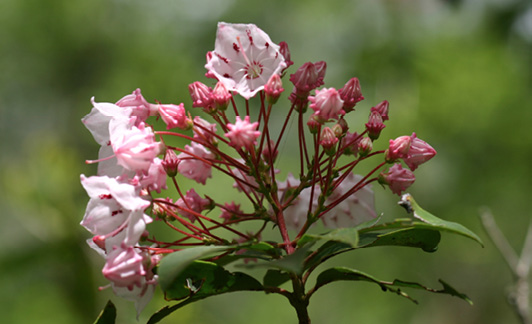
Mountain laurel is an evergreen shrub that often reaches 10 feet in height and width. It grows on the slopes of rivers and creek banks across the eastern United States. Mountain laurel has an open, broad-spreading form with multiple branches. The foliage is dark-green, medium-textured, and slow-growing. Exquisite white or pink, wheel-shaped flowers cover the plant in spring. Mature plants exhibit an attractive, reddish-brown, peeling bark.
Sunlight: Shade to part shade
Soil type: Dry to moist
Shrub type: Evergreen
Wildlife value: Low
Flowering: Spring flowers
Lyonia
Lyonia lucida (Lam.) Koch
Family: Ericaceae
This evergreen shrub averages 3 feet in height and spread. Found growing along well-drained, sandy woodlands and streams, it is widely tolerant of many growing conditions. Small, nodding, bell-shaped, white flowers cluster along the stems in late spring. Lyonia has a low, mounding form with arching branches. Caterpillars are associated with lyonia but do not cause major injury. This shrub performs at its best in the coastal areas of the state.
Sunlight: Part sun to shade
Soil type: Dry or moist
Shrub type: Evergreen
Wildlife value: Low
Flowering: Spring flowers
American Sweet Olive
Osmanthus americanus (L.) Gray
Family: Oleaceae
An evergreen shrub that reaches up to 20 feet in height and 10 feet in width, American sweet olive is the native version of the more common Asian species. Found in dry, acidic soils of pinelands, this shrub has an oval, open form. Rather than blooming in winter as the Chinese sweet olive does, this native plant blooms in early spring. Small, white flowers occur on new wood and are not as heavily fragrant as the common ornamental. This shrub has few problems or pests and is particularly useful as a hedge or screen.
Sunlight: Sun to part shade
Soil type: Dry or moist
Shrub type: Evergreen
Wildlife value: Low
Flowering: Spring flowers
Honeysuckle Azalea
Rhododendron canescens (Michx.) Sweet
Family: Ericaceae
Honeysuckle azalea is a beautiful deciduous shrub that grows 12 feet high and 8 feet wide. This azalea is widely found along stream banks and rivers of the state. It performs best in filtered light; the foliage tends to burn in full sun. Large, fragrant flower clusters range from pure-white to dark-pink and bloom from late March to early April. This azalea is more adaptive of soil types than the yellow native azalea, and there are many cultivar types available.
Sunlight: Part sun to shade
Soil type: Dry to moist soils
Shrub type: Deciduous
Wildlife value: Low
Flowering: Spring flowers
Summer Azalea
Rhododendron serrulatum (Sm.) Mill.
Family: Ericaceae
Summer azalea is a deciduous shrub that grows to 15 feet in height and about 10 feet in width. Native to flood plains along streams, this azalea is tolerant of wet soils. Rather than blooming in spring as other azaleas, this species blooms from June through August with extremely fragrant, white flowers. It tolerates and blooms well in heavily shaded locations.
Sunlight: Part shade to shade
Soil type: Moist to wet soils
Shrub type: Deciduous
Wildlife value: Low
Flowering: Summer flowers
Snowbell
Styrax americanus Lam.
Family: Styracaceae
A little-known deciduous shrub, snowbell grows to 10 feet high and 6 feet wide. It is found in wet soils of bottomland hardwood forests and along stream edges. It has numerous small, white flowers that bloom from April through May. It typically has an upright, oval form.
Sunlight: Sun to part sun
Soil type: Wet or moist
Shrub type: Deciduous
Wildlife value: Medium
Flowering: Spring flowers
True Huckleberry
Vaccinium arboreum Marshall
Family: Ericaceae
This large, semi-evergreen shrub reaches 20 feet in height and 15 feet in width. It is found in a wide range of woodland types from dry, sandy soils to moist stream edges. Small, bell-shaped, white flowers appear on the plant from April through May and are followed by small, black fruits in early fall. The fruits are highly used by song and game birds, deer, and many small mammals. Because of this plant’s upright form, it can be used as a small ornamental tree. It has attractive red bark. Leaves of huckleberries and blueberries turn a vibrant, strong red in the fall.
Sunlight: Sun to part sun
Soil type: Dry to moist
Shrub type: Semi-evergreen
Wildlife value: High
Flowering: Spring flowers
Fruit: Summer fruits
Elliot’s Blueberry
Vaccinium elliottii Chapm.
Family: Ericaceae
This wild blueberry is a deciduous shrub that grows 12 feet high and 12 feet wide. It thrives in open pinelands, marshy edges, and along streams and roadsides. Small, white blueberry flowers bloom from March through May and are followed by small, edible, black fruits in early summer. The shrub has a loose, round form and often exhibits bright-green stems. The green leaves are small and turn bright-red in the fall. It has few insect or disease problems.
Sunlight: Sun to part sun
Soil type: Moist to wet
Shrub type: Deciduous
Wildlife value: High
Flowering: Spring flowers
Fruit: Summer fruits
Arrow-Wood Viburnum
Viburnum dentatum L.
Family: Caprifoliaceae
Arrow-wood viburnum is a large, deciduous shrub that reaches 20 feet in height and 10 feet in width. It is found mainly in acidic soils and moist soils of swamp forests and floodplains, but also adapts well to many soil types. Arrow-wood has an attractively toothed leaf that turns yellow and red in late fall. White flower clusters appear in March through May, and are followed by numerous blue fruits in late summer. Many birds and mammals use these fruits. The narrow, upright form of long, thin branches makes this variety of viburnum a useful shrub for narrow beds and courtyard plantings.
Sunlight: Sun to part sun
Soil type: Dry to wet
Shrub type: Deciduous
Wildlife value: High
Flowering: Spring
Fruit: Summer fruits
Staghorn Sumac
Rhus typhina L.
Family: Anacardiaceae
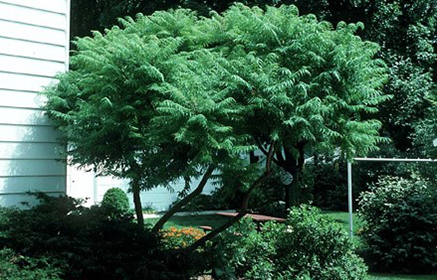
Staghorn sumac is a tall, deciduous shrub that reaches 20 feet in height and width. It grows in dry soil types along roadsides and in fields and pastures. The long, pinnate (feather-shaped) leaves are attractive and turn bright-orange or red in autumn. Flower clusters are green when they appear on the plant in early summer and mature to rich-red fruits before fall. These fruits often persist through winter. This is a tough and versatile shrub for difficult soil types. It often forms broad colonies through root suckering.
Sunlight: Sun to part sun
Soil type: Dry to moist
Shrub type: Deciduous
Wildlife value: High
Fruit: Late summer fruits
Dwarf Palmetto
Sabal minor (Jacq.) Pers.
Family: Arecaceae
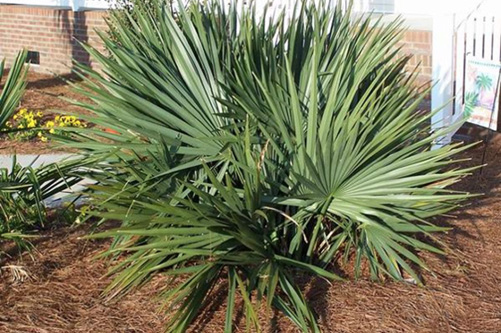
This versatile evergreen shrub grows 6 feet high and 4 feet wide. Found primarily in river flood plains, this shrub can grow in a wide variety of wet or dry soil types. Dwarf palmetto has a tropical leaf and is an excellent understory shrub, ground cover, or focal plant. Round, black fruits appear on long stems in late summer and persist through winter. Few insects or diseases are associated with this species.
Sunlight: Sun to shade
Soil type: Dry or wet
Shrub type: Evergreen
Wildlife value: Medium
Fruit: Late summer fruits
The information given here is for educational purposes only. References to commercial products, trade names, or suppliers are made with the understanding that no endorsement is implied and that no discrimination against other products or suppliers is intended.
Publication 2334 (POD-07-21)
By Robert Brzuszek, Extension Professor, Landscape Architecture.
The Mississippi State University Extension Service is working to ensure all web content is accessible to all users. If you need assistance accessing any of our content, please email the webteam or call 662-325-2262.

